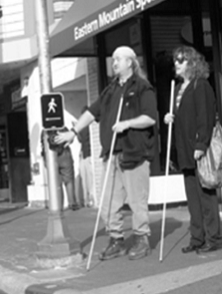Common Problems with APS Installation
This technical assistance guide is designed to provide information on common problems that arise in the installation of accessible pedestrian signals (APS). APS are most frequently provided at the request of a pedestrian who has a vision impairment. Current Federal Highway Administration (FHWA) policy requires State and local highway agencies to consider APS and to develop a “reasonable and consistent plan to facilitate safe street crossings” in existing developed rights-of-way. Chapter 4E.06 of the Manual on Uniform Traffic Control Devices (MUTCD 2003), adopted by State Departments of Transportation under the Federal-aid Highways Act, contains technical provisions for APS, where they are newly installed. The Access Board’s draft Public Rights-of-Way Accessibility Guidelines (draft PROWAG) includes APS provisions that have been harmonized with MUTCD. However, the Access Board has not yet finalized its rights-of-way rulemaking, nor has it been adopted as an enforceable standard by either the Department of Justice under Title II of the Americans with Disabilities Act or the Department of Transportation under Section 504 of the Rehabilitation Act of 1973.
June 2009

Prepared by:
Janet M. Barlow, COMS, Accessible Design for the Blind
AUTHOR’S CONTACT INFORMATION
Janet M. Barlow, COMS (Certified Orientation and Mobility Specialist)
Accessible Design for the Blind
3 Manila Street
Asheville, NC 28806
Phone: 770-317-0611
Email: jmbarlow@accessforblind.org
Pedestrians who are blind or have low vision using APS devices, as well as orientation and mobility professionals and signals engineers reviewing recently-installed APS in the field, have noted many deficiencies in the location, operation, and usability of pedbuttons and pedestrian signals. This technical assistance bulletin highlights key issues that have figured in many of these reports; its countermeasures are consistent with usability for pedestrians who have vision loss, with APS specifications in the current (2003) Manual on Uniform Traffic Control Devices (MUTCD) and the proposed MUTCD (2009), with recently-completed NCHRP research, and with APS provisions in the draft Public Rights-of-Way Accessibility Guidelines (PROWAG).
ACKNOWLEDGEMENTS
Photos in this paper are by the author, Lukas Franck, The Seeing Eye, Rafael Martinez, Martinez Engineering Group, Brett Rouillier, District of Columbia Department of Transportation, Dona Sauerburger, COMS, and Lois Thibault, US Access Board. Figures 2, 3, and 6 are from Accessible Pedestrian Signals: A Guide to Best Practice, developed for NCHRP Project 3-62.
SUMMARY
Incorrectly aligned or located APS devices provide ambiguous information in an environment in which few other cues may be available. Careful evaluation of every pedestrian signal installation is needed to assure that it meets the goals of providing accurate and helpful information to pedestrians who have vision impairments, particularly those who may also have hearing loss. Whether APS are installed at the request of a local resident or as part of a new pedestrian signalization scheme, they must function properly if they are to be useful in communicating the information provided to sighted pedestrians by visual pedestrian signals.
For more information, see resource material developed as part of the National Cooperative Highway Research Program Project 3-62: Guidelines for Accessible Pedestrian Signals at http://www.walkinginfo.org/aps/ or NCHRP Web OnlyDocument 117A.
Appendix
A checklist for evaluation of installations, adapted from Accessible Pedestrian Signals: A Guide to Best Practice, NCHRP Web Only Document 117A, is included here as Appendix A.


